Here is a list of puzzles that have withstood the test of time (some decades, anyway).
It sometimes seems like they've been around since the cave paintings, but actually most mechanical puzzle
designs are relatively recent (from the late 1800's), as you'll discover if you poke around in patents databases.
By reason of popularity, notoriety, and clever design,
they have never lost the attention of the puzzle community or of manufacturers,
nor of some share of the general public.
They continue to inspire frustration and contemplation.
And though I'm sure there are those who won't share my feelings here,
these are among the most hackneyed, tired, boring puzzles I can think of.
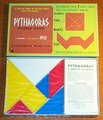
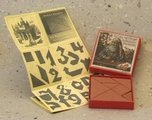
|
Tangram, Anchor puzzles - come on, aren't these "soft puzzles" for people who don't really like puzzles?
They're just this side of a jigsaw, for crying out loud.
Tailor-made for mass-production and page-a-day calendars, though.
|
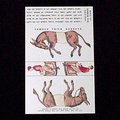
|
Seat the Riders - OK, I get it. Does anybody not get it?
|
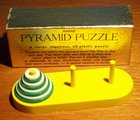
|
Towers of Hanoi - a great programming introduction to recursion,
and I suppose a great way to while away the time waiting for the universe to implode.
Also see...
|
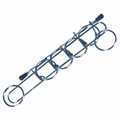
|
Chinese Rings / Patience
(but see SpinOut or Mag-Nif's The Brain for a more entertaining modern take on the Gray Code)
|
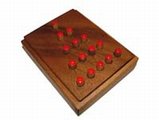
|
Peg Solitaire and Transpositions - sure, I play with them at the Cracker Barrel like everyone else.
But read Winning Ways for Your Mathematical Plays and soon you'll be pursuing post-packaged past-times.
|
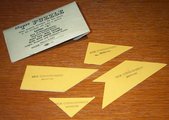
|
Dissected T - how many morons are going to sell or display it using a photo of the solution configuration?
For a puzzle often made of cardboard, that pretty much sucks away the last remnant of fun, doesn't it?
|

|
2-piece pyramid - been there, done that, got the t-shirt.
|

|
puzzle ring - oops - darn!
|
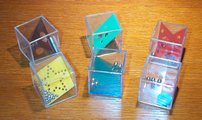
|
Pigs in Clover; really, any ball-in-maze puzzle/game - I shudder to think how many of
these things lie in landfills, waiting for future ages to think they were some sort of
religious icon like a prayer fan or something.
|
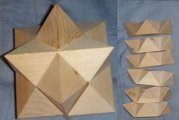
|
6-piece diagonal star - can Cardinal churn these things out any faster???
Entire Indonesian forests must lie in ruins.
|
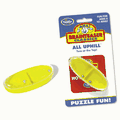
|
Dipsy-doodle / Moses' Cradle - an archetype, but if you've seen one, you've seen them all.
|

|
elastic cube snake - simultaneously keeping both the elastic and cube industries alive...
|
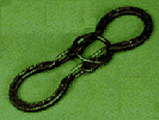

|
horseshoes, linked hearts - more archetypes, but how many versions do we really need?
|
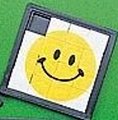
|
15 slider - another marketeer's dream.
|

|
Checkerboard dissections - Read Haubrich if you think you've seen them all...
and then you'll realize you'll never see them all
|
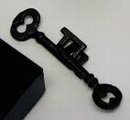
|
linked keys, tip key - can't anyone come up with a better mousetrap?
|
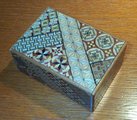
|
traditional japanese box - from a country where the architecture has evolved to survive earthquakes,
you'd think they'd build these things a little sturdier.
I guess the use of actual glue is only permitted in the really expensive ones.
|

|
kumiki figures
|

|
2 bent/linked nails
|
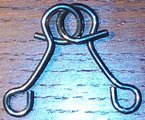
|
double rings or twists
|
Since this is a mechanical puzzle site, I'll leave
jigsaws alone.
And since this is all tongue-in-cheek (no, really) please don't revoke my puzzle-collector's license.
On the other hand, here are a few "classic" designs that I believe warrant my (if not anyone else's)
continuing interest.
Sadly, many of them are no longer produced. Go figure.

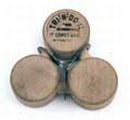
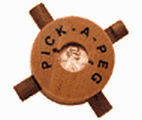
|
Takitapart, Tri-n-do-it, Pick-a-peg -
This set of three has been called the "Masterpiece Puzzles" and not without merit, I think.
|


|
marble inside barrel, coin safe - still as good as in Hoffmann's day.
|

|
trick bolts - OK, the 3 classic designs are a little long in the tooth, but fortunately
there are a few artisans who continue to produce innovative designs.
|
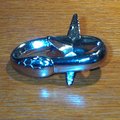
|
Snake and Star
|
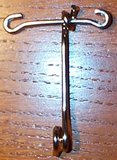
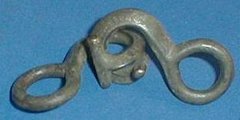
|
Post and Twirls, and Devil's Keys - of all the cheapo wire puzzles, I think these remain the most interesting.
|
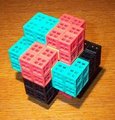
|
6-piece burr - now some of you are thinking you've got this t-shirt, too.
I used to think that, but then I realized I hadn't had the full tour. See LiveCube later on.
|

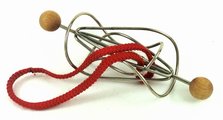
|
Ball and Chain tangle, and
Loony Loop / Gordian Knot tangle - still get that "It can't be done!" reaction.
|

|
Columbus' Egg balancing - we're due for a new one, aren't we?
|
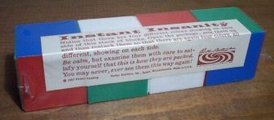
|
Instant Insanity (yes, the basic principle is that old - see the Katzenjammer patent)
|
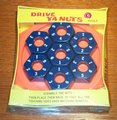
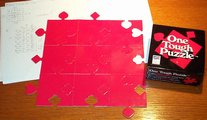
|
edgematch / heads-tails like Drive Ya Nuts or One Tough Puzzle
- but for the love of Pete, stop with the scramble squares already!!!
|
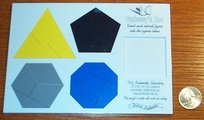
|
dissections - plain/plane and fancier...
|
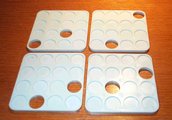
|
8 queens - I've never bothered to memorize even one of the twelve solutions,
which is probably why this puzzle continues to amuse me like a bubbling treasure chest
amuses a goldfish with no long-term memory.
I'm still having fun discovering the various guises it has assumed over the years.
|
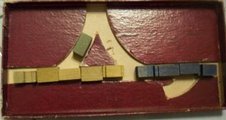
|
railroad shunting - I'm not into model railroading, otherwise this would be off the geekometer
|

|
sliding block - e.g. Dad's Puzzle and Quzzle - but as a kit -
someone ought to make a generic board and piece set and include a comprehensive booklet of all
the classic problems as well as the latest designs
and, hey, solutions. Just like Tangrams. But chewier. Thinkfun, are you listening?
|
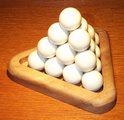
|
ball pyramids - e.g. Gordon Bros., Pyramystery - also as a kit, hey, just like Lonpos
(but $118? Get real!)
|

|
tanglements, cast, string - still resisting computer attack,
they'll remain out there on an expanding frontier, taunting us (until Dick Hess hunts them all down, anyway).
|
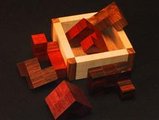
|
box packing - but somewhere there oughta be a limit on the number of pieces or the wackiness of shapes
|
|
Which do you have a soft spot for?
|
Then there is the following group of puzzles that date from, say, the 1960's onwards.
These are my take on the "Modern" classics.
Some of them have entered the public zeitgeist, while the fame of others resides only among puzzle people.
Their appeal has not yet worn off on me, though I am sure
some yahoo a few decades hence will be yawning about them.
I'd be surprised if you haven't seen most of them, but
if you haven't played with them and you're looking for some puzzle fun, I don't think you can go wrong here...
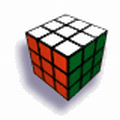
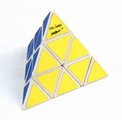
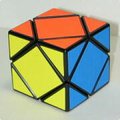
|
Magic Polyhedra: Rubik's Cube (3x3x3), Pyraminx, The Skewb -
these three internal mechanisms (6-armed spider, ball, and 4-armed spider) have given rise to an unbelievably
rich domain. You're from some other dimension if you haven't heard of Rubik's Cube.
|

|
Diabolical cube -> Soma -> Impuzzables -> Convolution, Mayer's Cube -> endless variation.
Better yet, skip them all and get yourself some LiveCube, a copy of Kevin Holmes' book,
and a web connection to Ishino's site.
|

|
Lights Out - people are still trying to figure out how to use electronics and the
computer to make better puzzles, and the modern puzzle landscape is littered with
versions of solitaire, mah-jongg, and adventure games.
Lights Out remains an accessible and entertaining puzzle that could only really be
implemented well using electronics.
Push-button convenience, and an easy reset - in a hand-held package that doesn't require
constant security updates. What more could one ask?
There are a few other notable puzzles in software form, such as Sokoban, but they just haven't achieved
the same level of appeal.
And I'm not even going to discuss the SuDoKu craze - what idiot thinks that belongs in the
Vintage Puzzles section of eBay???
|
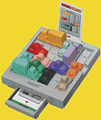
|
Rush Hour - Thinkfun is a real class act. Period.
|
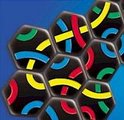
|
Tantrix
|


|
Spin-Out / The Brain - the Gray Code made flippin' fast. Take that, Patience!
|
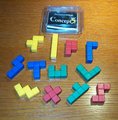
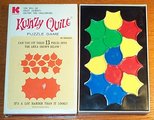
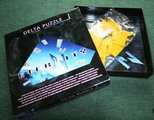
|
Pentominoes & other polyshape families - e.g.
Kwazy Quilt, Eternity Delta - might bore some, but they probably haven't checked out Ed Pegg's or the
Glorieux Ronse site.
|
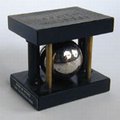
|
Alcatraz - a modern archetype.
|
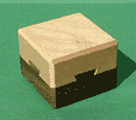
|
Dovetail joint - another modern archetype.
|
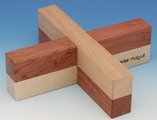
|
Duallock - ups the ante on the old dipsy doodle theme.
Good enough to be cheaply imitated.
|


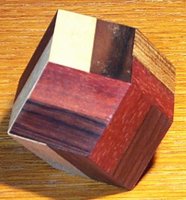
|
Hectix, Corner Cube, Garnet -
any of Stewart Coffin's interlocking designs.
The much-copied modern master of Ap-Art.
|
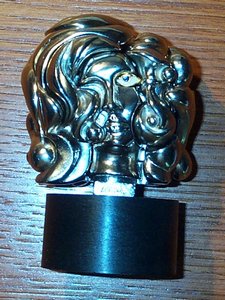
|
Berrocal minis & others - make you feel all grown up.
The answer to those who ridicule your obsession.
(Or you can show them a Maxton, if you want ridicule along the lines of "ARE YOU NUTS???")
|
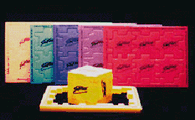
|
Happy Cubes or Snafooz - Happy, happy, happy. Happy marketeers. Trade show swag. But fun.
Also edible and now in fruit flavors. Just kidding.
|
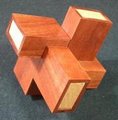
|
Oskar's Matchboxes - Oskar is a genius, for this and too many other reasons.
|
Here is a list of puzzles which should be available for purchase if you're persistent and lucky.
I think this bunch would be a good starter set for a new collector.
And for the record I am not on Thinkfun's payroll...
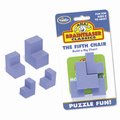
|
Fifth Chair - Thinkfun
|
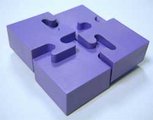
|
4-piece jigsaw - Thinkfun
|


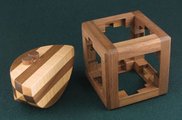
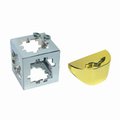
|
Sunflower / O'Gear, and
The Wanderer / Cuby - Hanayama has been absolutely great at bringing wonderful old and new designs to the mass market.
|

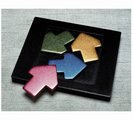

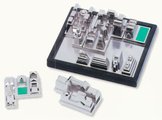
|
These four packing puzzles have proven themselves time and again at my parties:
Hercules, Packing Arrows, Pencils, City.
And once the inlays fall off the Pencils, you shouldn't have to worry about anyone damaging any of these.
|
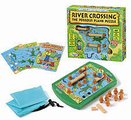
|
River Crossing
|
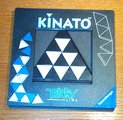
|
Kinato
|
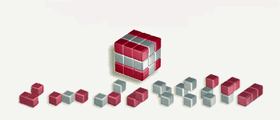

|
Rubik's Bricks or Patio Block if you're bored with Soma and you've mastered all the Impuzzables
|
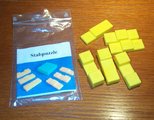
|
Stabpuzzle - don't let the name put you off. This is a non-violent PG-rated affair.
|
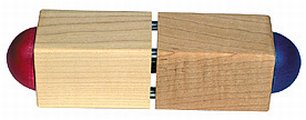
|
Bipolar - Orb Factory
|


|
Dan Lock and the Lunatic Lock
|
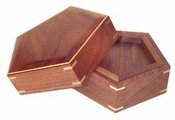
|
The Kamei Pentagon Box and other
new trick boxes from the Karakuri Club - consider a membership. These are far beyond the old Himitsu-Bako.
|
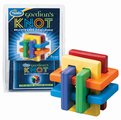
|
sample some non-traditional burrs - e.g. Thinkfun's Gordian Knot - you think six pieces won't humble you, eh?
|


|
Suffacator and Tricky Dick,
both great tangle designs that should stump you for a while and make you
think about them even when you're not playing with them.
|
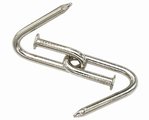

|
Last Nail in the Coffin, and Trumpets/Twisted - so much better than their progenitor.
|

|
r2d2 by Roger - assuming you can find one. Just don't share your copy.
|
|
Eagerly awaiting the next one...
|
From
dictionary.com:
puzzle, n.
1. Something, such as a game, toy, or problem, that requires ingenuity
and often persistence in solving or assembling.
I like this definition and I think it conveys that the intent of a puzzle is to entertain,
while testing both ingenuity and persistence.
Obviously the implication that the objective is merely assembly is misleading...
taxonomy, n.
1. The classification of organisms in an ordered system that indicates natural relationships.
2. The science, laws, or principles of classification; systematics.
3. Division into ordered groups or categories.
classification, n.
The systematic grouping of organisms into categories on the basis of evolutionary or structural
relationships between them.
category, n.
1. A specifically defined division in a system of classification; a class.
2. A general class of ideas, terms, or things that mark divisions or coordinations
within a conceptual scheme...
class, n.
1. A set, collection, group, or configuration containing members regarded as having
certain attributes or traits in common; a kind or category.
Whew - some frustrating circular reasoning there if you ask me...
Anyway, people seem to have a natural bent for noticing distinctions and grouping things by such distinctions. The history of science is riddled with schemes to classify things - some successful, some misguided. People have, of course, made attempts at developing a classification scheme for puzzles - with varying degrees of success. James Dalgety and Edward Hordern came up with a scheme - but James himself has told me he is not fully satisfied with it.
I have some thoughts on the subject, too. Let me start by relating an interesting item I recently read in the book "Leonardo's Mountain of Clams and the Diet of Worms" by the noted scientist and essayist Stephen Jay Gould. It is a cautionary tale of an error committed by an otherwise intelligent and well-intentioned scientist of the 1700's named Emmanuel Mendes da Costa, a contemporary of the great taxonomist Carolus Linnaeus.
In 1757 Mendes da Costa published his major work "The Natural History of Fossils." In those days the term "fossil" meant any natural object taken from the earth and in particular rocks and minerals - in contrast to our current use of the term exclusively for the remains of once-living things. Whereas Linnaeus developed and applied his theories of taxonomy to living things with great success, Mendes da Costa (and to an extent even Linnaeus himself) overextended the application of the theory to areas where it didn't belong. Minerals are not genealogically related and their order cannot be expressed by a treelike geometry. Furthermore the theory cannot be applied to intergrading compositions - where no discrete species can be clearly isolated.
My takeaway from all this is that we should be careful about how we choose to classify our puzzles - we should avoid the temptation to rely on structural similarities and percieved "lineage." We should also beware of becoming mired in attempts to categorize "intergrading compositions" - puzzles composed of a mixture of elements or operational principles. (And I should also not push analogies too far...)
I, for one, would have to say that I believe the Linnaean system based on structural
similarity will have to yield to a system based on genetics
(at least for classification of organisms for which genetic samples are available).
What is the value of developing a classification scheme? I can think of several purposes:
- provide a framework for organized discourse,
establishing a commonly understood terminology
- provide a means for measuring a collection and comparing among collections
- provide a system in which "gaps" might lead to new directions in puzzle thinking
(kind of like how the Periodic Table provided a fruitful framework leading to the
discovery of new elements)
Here is my take:
first, some (OK, a lot of) definitions...
A mechanical puzzle is a set of one or more discrete physical objects.
Each object in itself may have one or more integral physical sub-components which cannot be detached.
Each object or sub-component may (must?) have one or more physical traits which in some way distinguish it - for example, a color, pattern, texture, magnetic field, or shape. Each trait has a domain of possible values and its value may be (but need not be) changeable (for example a light which can glow different colors).
The object(s) can be arranged in three-dimensional space, and their orientation in space and in relation to each other are usually important, as is the value of each trait.
Puzzles in more than 3 physical dimensions have been imagined (hypercubes...)
Puzzles in truly only two dimensions are drawings (even a paper jigsaw has a 3rd dimension, though it might not be a salient feature, and the pieces can be flipped in space).
The orientation of the pieces in space and in relation to each other, and the value of each trait, is the puzzle's state.
A puzzle usually has one or more distinct special states known as goal states - when the puzzle is in a goal state it is considered solved.
A puzzle also usually has one or more distinct special states known as start states - though the set of start states might be a very large set of random chaotic arrangements of pieces.
Some mechanical puzzles also involve the dimension of time... a particular sequence of states is of importance.
One key precept is that the puzzle must contain in itself all elements required for its solution.
Original thinking may lead a designer to violate this precept in some clever way (for example puzzles that require blowing or sucking, or exposure to or isolation from heat or light) - though it would seem that the external dependency must be on some ubiquitous environmental feature.
Another key precept is that no destructive deformation of the puzzle is required to solve it.
This, too, might be creatively violated, but probably in such a way as to permit easy replacement of the damaged piece(s) - again with something ubiquitous in the environment - easily and cheaply obtained.
To be entertaining and desirable, a puzzle should be fun to solve and manipulate. Ideally the solution process provides encouraging feedback of some kind.
This definition will blur at the edges - few will consider a normal Master Lock a mechanical puzzle, but some do. It includes jigsaw puzzles, though many mechanical puzzle collectors do not favor them. I think it a good thing to have blurry edges - it encourages exploration.
One class of puzzles fitting this general definition are "poly-solid" assemblies (like Soma).
Here is an approach to automating the solving of such puzzles:
The program will accept a list of definitions of pieces comprising a puzzle.
Each piece is composed of one or more unit solids from a set of primitive unit solids
(typically all pieces are composed of the same unit solid, such as cubes, spheres, or tetrahedrons, but a set of more than one unit solid may be employed such as spheres of different sizes, for example to model salt crystals using Na and Cl atoms, or for another example the Kuball)
Each piece will be assigned an overall identifier unique within the scope of the puzzle, and each unit of a piece will be assigned an identifier unique within the scope of the piece.
The piece definition will include information on how the units of the piece relate in space.
Also specified will be a "hull" comprising a specific number of points arranged in a lattice.
Each point will have a set of adjacent points and information (either explicit or implied) regarding how they relate in space.
The well-known space-filling regular crystal lattices may be used, though irregular "tilings" might be possible.
The simplest lattice for a cubic poly-cube puzzle is the simple cubic lattice - each lattice point can be viewed as occupied by the center of a unit cube belonging to a piece, with units joined into pieces by mating on full faces.
Other possible lattice structures:
- body-centered cubic
- face-centered cubic (cubic closest packed)
- simple hexagonal (units in adjacent layers directly on top of each other)
- hexagonal closet packing (ABABAB...)
- cubic closest packed (ABCABCABC...)
Each lattice location will be assigned a unique identifier within the scope of the puzzle.
The units will typically be joined into pieces obeying some kind of rule -
for example using full-face matings, or half- or quarter- face matings, etc.
However, clever means of joining units are also possible -
for example wires that join cubes at their corners or along edges
(in such a way that the wires themselves do not occupy lattice locations or otherwise
constrain the placement of the pieces within the lattice and in relationship to each other).
(If in fact the joinings do offer constraint then a more robust model than this is required.)
In the most abstract sense, the joining does not matter -
all that matters is the spatial relationship of the pieces with respect to valid lattice points.
A true abstract piece might be composed of a set of disjoint units that nevertheless obey the lattice geometry.
How such a piece might be realized without "force fields" is a challenge!
The object of the puzzle is to find a mapping of piece units to hull lattice points such that:
- 1) all units are mapped
- 2) no more than one unit is mapped to a given lattice point
- 3) adjacent units within a piece map to corresponding adjacent points within the lattice
- 4) the unit maps to a point that accomodates that type of unit
Approach
For each piece, find its set of all legal mappings within the hull respecting rules (3) and (4).
Then,
For each piece, for each of its mappings,
attempt to combine it with a mapping of the next piece, subject to rule (2)
Continue until either all pieces have been mapped, in which case record a solution
or the next piece cannot be mapped, in which case backtrack.
Possible optimizations:
- Avoid the redundant exploration of symmetric positions and solutions,
but in such a way as to not miss any valid unique solutions
- Apply heuristics to the order in which pieces are considered,
and the order in which their orientations are considered.
- Save intermediate computations to permit recovery in the event of interruption
In general, to automate a solution, certain things about the puzzle must be clearly established - here is a somewhat formalized list of such requirements:
Instantiation
- I1) The set of physical components -
descriptions, materials, dimensions, etc
(some info is not pertinent to abstract state, but related to desirability)
State abstraction and recognition
- S1) A complete & salient way of specifying the puzzle's state -
what is the minimum set of facts that must be tracked to clearly,
comprehensively, and succinctly distinguish all possible states from one another
(assign a unique reference identifier for each unique state)
- S2) Is any information hidden - hidden information withheld from the algorithm
can defeat the attempt at automation - causality and a feedback mechanism must be
properly modeled
- S3) The ability to compare states and determine equivalence
(aids pruning of search space, and used for recognition of goal state)
Special states
- G1) set of goal states
- G2) set of initial states (if unimportant, then simply choose a specific state)
- G3) any other special states - e.g. desirable intermediate
Actions
- A1) The ability to describe and unambiguously identify the universe of all possible actions (domain)
- A2) The ability to filter useful actions - i.e. distinguish those which alter state meaningfully versus those that do not
- A3) For each state and possible action, the ability to determine "legality" of the action within framework of established rules - may require knowledge of state history not just current state (even hidden info)
- A4) For each state, the ability to propose/enumerate all possible useful and legal actions available at that state
- A5) also should be able to assess invertability of actions -
- A5i) can we deduce specific previous state from current state and last activity
- A5ii) are all/some/none actions their own inverse or do they have inverse actions
- A6) are all actions unlimited re-usable or are there limitations either physically or rules-imposed - e.g. use-once like castling or 3 life-lines
State transitions
- T1) Must be able to model state transitions - for each state and possible legal action, require the ability to determine the resulting state - i.e. discrete changes to all pertinent "traits" - there is an assumption that the state transition diagram is deterministic and non-fuzzy.
- T2) A typical search algorithm requires the ability to record a history of actions taken and states traversed (usually modeled external to the model of the puzzle itself - e.g. tree/graph/stack record-keeping tactic for analysis and automated search)
Heuristics
- H1) Feedback mechanism(s) - static state evaluation - for each state, the ability to predict and assess an action's contribution to progress or distance from goal/ ability to judge utility of action relative to other possible actions - aids goal-directed exploration of search space - the perfect evaluator results in the discovery of "God's Algorithm" - a solution in the most direct sequence or smallest possible number of actions (which may be smaller than the number of actions taken to scramble the puzzle)
- H2) heuristics / experiential/expert knowledge - to make use of heuristic aids, one must be able to articulate them a priori or derive them on the fly, represent and store them economically, recognize when it is appropriate to apply them and search for/find them efficiently, correlate them to state/match, and guide/apply to activities
- H3) ability to avoid ruts - escape from local minima/maxima encountered in the course of search
I believe a taxonomy/classification is possible by some of these...
What is the minimum set of salient facts about the puzzle that can comprehensively and succinctly distinguish all possible states?
Is any information hidden - or rather, what impact on action/state transition does the hidden information have?
What is the nature of the goal state(s)? - for example:
separation of pieces or
arrangement/engagement of pieces according to specific criteria...
What is the universe of all possible actions? Is it easy to filter useful actions? How is legality determined?
Is the state transition diagram in fact deterministic?
What are the feedback mechanisms?
What heuristics apply?
It seems to me that existing taxonomies focus on:
- the nature of the goal states
- the set of useful and legal actions
My preference would be to somehow focus on the state representation and state transition diagram.







































































